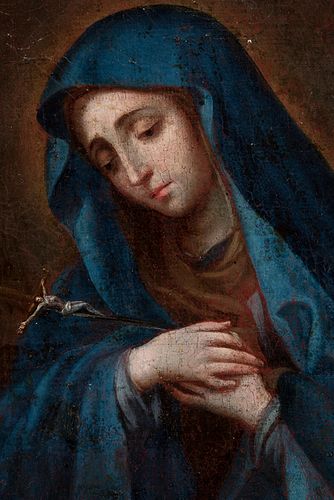Circle of MIGUEL CABRERA; XVIII century. "Dolorosa with legend". Oil on canvas.
Lot 3
About Seller
Setdart Auction House
Carrer Aragó 346
Barcelona
Spain
Setdart Subastas was born in 2004 and is currently the first online art auction in Spain with solidity, prestige and reliability guaranteed by our more than 60,000 users. Setdart has a young, dynamic and enterprising team ready to successfully manage the purchase and sale of art works through custom...Read more
Estimate:
EUR€2,000 - EUR€2,500
$2,127.66 - $2,659.57
Absentee vs Live bid
Two ways to bid:
- Leave a max absentee bid and the platform will bid on your behalf up to your maximum bid during the live auction.
- Bid live during the auction and your bids will be submitted real-time to the auctioneer.
Bid Increments
| Price | Bid Increment |
|---|---|
| EUR€0 | EUR€10 |
| EUR€200 | EUR€25 |
| EUR€500 | EUR€50 |
| EUR€1,000 | EUR€100 |
| EUR€3,000 | EUR€200 |
| EUR€5,000 | EUR€500 |
| EUR€10,000 | EUR€1,000 |
| EUR€20,000 | EUR€2,000 |
| EUR€50,000 | EUR€5,000 |
About Auction
By Setdart Auction House
Oct 20, 2021
Set Reminder
2021-10-20 07:30:00
2021-10-20 07:30:00
America/New_York
Bidsquare
Bidsquare : OLD MASTERS
https://www.bidsquare.com/auctions/setdart-auction-house/old-masters-7700
Setdart Auction House sofia@setdart.com
Setdart Auction House sofia@setdart.com
- Lot Description
Circle of MIGUEL CABRERA; XVIII century. "Dolorosa with legend". Oil on canvas. Relined Presents repainting and restorations and inscription on the back. Measures: 37 x 27 cm. In this devotional work the painter presents Mary as Mater dolorosa, located on a neutral background that highlights the monumentality of the figure. The Virgin is portrayed in this moment after the death of her Son, suffering and feeling a deep pain that appears symbolically represented with the form of a sword that pierces her heart. The devotion to the sorrows of the Virgin has its roots in medieval times, and was especially spread by the Servite order, founded in 1233. There are many and varied iconographic representations that have as central theme the Virgin Mary in her Sorrowful aspect, being the first of them in which she appears next to the Child Jesus, who sleeps oblivious to the future of suffering that awaits him. The image of devotional character, is inscribed in an oval in whose perimeter the legend can be read; To devotion of Don Juan Ortega Montañez, Cº, D. M. O d De Michoacan and Virey of the New Spain. This legend refers to Juan de Ortega Cano Montañez y Patiño (Jaén; 1627 - Mexico, New Spain; 1708). He was a Spanish ecclesiastic and viceregal administrator. He was bishop of Durango, Santiago de Guatemala and Michoacán, in addition to becoming the 33rd virey of New Spain from 1701 to 1702. Due to its formal and technical characteristics, we can relate this work to the artistic circle of Miguel Cabrera, one of the greatest exponents of New Spain Baroque painting. Born in the town of Tlalixtac, in Oaxaca, he dedicated his work to religious themes and especially to the figure of the Virgin of Guadalupe, and on this last theme he wrote "American marvel and set of rare wonders observed with the direction of the rules of the art of painting" (1756). Cabrera was also the chamber painter of Archbishop José Manuel Rubio y Salinas, and in 1753 he founded the first painting academy in Mexico. Miguel Cabrera was especially splendid in small and medium-sized works, both on canvas and copper. Contrary to what was usual at the time, when in Spain the pictorial production of New Spain was generally disdained, a large number of his works or those of his workshop were sent to the peninsula, even after his death, commissioned or acquired by clients who included members of the most important and cultured Spanish families with relations with the American continent, such as the Marquises of Altamira, the Gálvez and Mayorga families. Currently his works are kept in several of the main Mexican temples, as well as in the Museo del Virreinato in Tepozotlán, the Museo de América in Madrid, the Museo de El Carmen in San Ángel (Distrito Federal), the Museo Nacional de las Intervenciones in Coyoacán, the Pinacoteca Virreinal in Mexico City, the Dallas Museum of Art and the Museo de Santa Mónica in Puebla.
- Shipping Info
-
In-house shipping available. Please inquire at admin@setdart.com.
-
- Buyer's Premium



 EUR
EUR CAD
CAD AUD
AUD GBP
GBP MXN
MXN HKD
HKD CNY
CNY MYR
MYR SEK
SEK SGD
SGD CHF
CHF THB
THB









